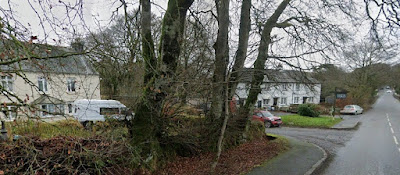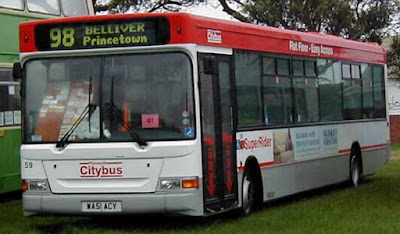Blame Sir Thomas!
Sir Thomas Tyrwhitt (1762 to 1833) was Private Secretary to the Prince of Wales and MP for Okehampton. He developed his estate (Tor Royal) on Dartmoor, and with a bit of help from his employer, he opened up a series of roads to give access to what was then very remote country.
He also proposed that a prison be built on Dartmoor to house the thousands of captives of the Napoleonic Wars and the later War of 1812, who had become too numerous to lodge in the prisons and prison-ships at Plymouth. The site was given by the Prince of Wales, who held the lands of the Duchy of Cornwall to which the whole moor belonged. This is why the settlement is named Princetown. Dartmoor Prison was built in 1806 at a cost of £130,000. At one time it had a capacity of between 7,000 and 9,000 prisoners, but its current capacity is only 640.
When the weather is grim, which it often is, Princetown is a dark and looming place, dominated by the unwelcoming and looming edifice of His Majesty's moorland guest house!It even looms when the sun shines!
The town was served by a branch line from Yelverton and, presumably due to the prison traffic, had a surprisingly good service for such a remote location.A bit like yesterday's line to Gunnislake and formerly Callington, it was not the slickest of routes.Most of the stops were simple halts serving little population.
Then Go By Bus
In summer 1996 you might choose Service 82. Mostly this was a seasonal route running from Plymouth to Exeter. fbb rode this route (with Mrs fbb who was less than excited by the opportunity) ...... but later it passed to Stagecoach ...... and finally the dregs ended up with Dartline.Then, much to everyone's surprise, back cane First with one of a whole swathe of "tourist" routes. The Dartmoor Explorer was born.Unfortunately, First's commitment has, so far, been limited to fitting trips in between school and college contracts. So the service does not run end to end. That is not too serious as the bit between Plymouth and Tavistock is not particularly enlightening - but a through route might have attracted more custom from the big cities at each end.
In 1996, the other way would be to use the local route from Tavistock.Five trips were available on service 98 from Tavistock to Princetown with extensions to Postbridge and, on Fridays (and Saturdays?) to Bellever.This is rural bus riding at its best. Here Two Bridges (count them) ...
... and Bellever.fbb guesses that this would not be the highest revenue per mile money spinner for Western National even back in 1996!
And today?
Astoundingly there is a still a bus to beautiful Bellever.What's more, Bellever now gets a bus on Monday to Saturday. The rest of the service is much reduced with just three trips to Princetown and Postbridges. The service is a Devon tender (as it almost certainly was in 1996) now operated by Plymouth City Bus.City Bus have held the contract for some time as experts in Plymouth liveries can testify!
There are two conclusions that come from Keith Shayshutt's book ...... One, how much commercial bus services have been reduced throughout the greater Plymouth area; but Two, how much remains to provide connections for those in rural areas who do not have the luxury of an motor car!
Surely this is a telling argument for questioning the wisdom of expecting necessitous public transport to be delivered by the commercial model.
Connectional Confusion ConsequencesWhen fbb connected a battery, the lights in the pub illuminates perfectly but, behind it, the church ...... did not illumine as above, but remained bereft of photons. fbb suspected a broken wire, so cut them and rejoined them.
LEDs are NOT like light bubs (of any size) because they only work if the electric flows through them in the right direction. So at one horrific point the church lights were on and the pub lights were off! Turn the battery round and the church lights were off and the pub lights were on!
Aaaaargh!
Solution : join the broken wires the other way round and, "let there be light" both bits shined brightly.
So with castle, pub/church and station lights all now working, fbb could experiment with linking them together with a common (and parallel) power supply.
Oh foolish one!
In went the volts and a gentle snapping sound emanated from the station as three LEDs exploded! The lights, surprisingly, didn't work any more!
After sitting in the cupboard under the stairs holding the foetal position tightly and swivelling steadily, fbb decided that he should be brave and tackle a repair of the station's illumination.
fbb has no idea what he did wrong, but he has reverted to the individual batteries that were delivered attached to each string of lights.
More in due course.
Somewhere in the bowels of this complex building was the universally unloved Midland Red bus station. It was horrible; cramped, overpowering and very pongy. Concerns about air quality were not very important back then!It was in the shopping centre that fbb first met a stall selling Brum's favourite (?) lactic liquid ...... namely sterilised milk. Its flavour is similar to slightly "plastic" diluted evaporated milk! It is ideally designed to ruin a cup of tea or coffee - but Brumagems from older generations still love it.
fbb observed but did NOT buy!
Next Variety blog : Saturday 18th February




























Plymouth CityBus has only recently returned to operating the 98; this, and the other Dartmoor routes 55/56 which are all interworked, were operated by Oakley's Coaches from October 2019 until 13th August 2022 and prior to that, by the now-defunct Target Travel.
ReplyDeleteAnother astounding fact about Bellever is that it’s first bus service did not run until November 1975 when a twice a month Friday minibus provided by a Mr Finch was subsidised by Devon CC to Princetown on an experimental basis to connect with Striplin’s ex WN 113 route to Tavistock. Four months later the route was extended through 8to Tavistock. At some point the service became weekly.
ReplyDelete